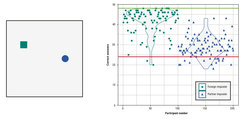Sample Project: Minimal Turing Test
Humans can overcome machine impostors and achieve communication even with minimal means.
Interactions between humans and bots are increasingly common online, and a pressing issue concerns the ability of humans to adequately discern whom they are interacting with. The Turing test is a classic thought experiment testing humans’ ability to distinguish a bot impostor from a real human by exchanging text messages (Turing, 1950). In the Minimal Turing Test project, we propose a version of the Turing test that avoids natural language. This allows us to study the foundations of human communication, as participants are forced to develop novel ways to signal their human identity even against bots that only copy human behavior faithfully. In particular, we investigate the relative roles of emerging conventions (i.e. repeating what has already proven successful before) and reciprocal interaction (i.e. interdependence between behaviors) in determining successful communication in a minimal environment.
Participants in our task could communicate only by moving an abstract shape in a 2D space (Figure 1). We asked them to assess their online social interaction as being with a human partner or a bot impostor. The main hypotheses were that access to the interaction history of a pair would make a bot impostor more deceptive and interrupt the formation of novel conventions between the human participants: Copying their previous interactions prevents humans from successfully communicating through repeating what already worked before. By comparing bots that imitate behavior from the same or a different dyad, we find that impostors are harder to detect when they copy the participants’ own partners (Figure 1), leading to less conventional interactions. We also show that reciprocity is beneficial for communicative success when the bot impostor prevents conventionality.
We conclude that machine impostors can avoid detection and interrupt the formation of stable conventions by imitating past interactions, and that both reciprocity and conventionality are adaptive communicative strategies under the right circumstances. Our results provide novel insights into the emergence of communication and suggest that online bots mining personal information, e.g., on social media, might become indistinguishable from humans more easily. However, even in this case, reciprocal interaction should remain a powerful mechanism to detect bot impostors.

Scientific writings
Müller, T.F., Brinkmann, L., Winters, J. and Pescetelli, N. (2023), Machine Impostors Can Avoid Human Detection and Interrupt the Formation of Stable Conventions by Imitating Past Interactions: A Minimal Turing Test. Cognitive Science, 47: e13288. https://doi.org/10.1111/cogs.13288
Key references
Turing, A. (1950). Computing machinery and intelligence. Mind, 59, 433–460.
